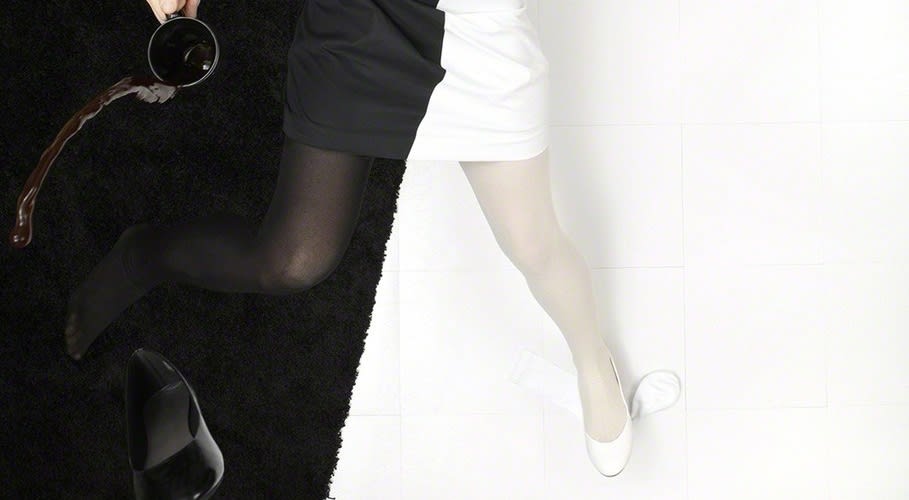
The images of Joana P. Cardozo and Margeaux Walter are visual dramas that reflect back to us our lives and how we live. These two artists, both photographers living and working in New York, tackle these concepts in their two very different bodies of work.
Where we live defines us. How we live is an expression of ourselves. What we surround ourselves with is visual evidence of our inner selves. Expressions of our temperament maybe reflected by what color is found in our space. The work of Margeaux Walter and Joana P. Cardozo takes us, the viewer, simultaneously, on a visual journey that challenges and measures our own sense of self and how we judge others.
Cardozo's images are internal landscapes. How a space is defined can be documentary or imagined. Joana P. Cardozo's "Blueprints" is a new topography. Topography is the arrangement and physical characteristics of a space or location. When the term "topography" is used in photography, there is an immediate association to the 1970's "new topography" movement that arose from Bernd and Hilla Becher maturing as the "Düsseldorf School". However, Cardozo's work is a new and different form of topography.
Cardozo defines space with the objects she finds in a person's household. The artist positions us to peer down from above into private lives. Most traditional landscapes are taken from eye level, except those that are aerial perspectives. These images are all perspectives from above. She starts, literally with an architectural outline of the apartment or house, by floor, in which her subject lives. The interior space is further defined by walls and doors. Within each room, Cardozo then photographs objects she feels reflect that person, their life and character. It is not just a photograph as one might expect. In the earlier images, it is an image of the shadow cast by the object. It is not the object itself. In some cases, she reveals more of the object rather than merely a dark shadow and outline. A color is then cast over the rendering, like a blanket. Cardozo selects the color based on her impression on what colors dominate the space. It is the color in which the residents of that home surround themselves. Cardozo has no real persons in her images. People exist within Cardozo's image only by virtue of the objects or animals that are evidence of their presence.
Images of objects can be literal or figurative. A shadow is not an object, but is evidence of an object's presence. A shadow is also a silhouette. Silhouettes were a classic technique in the years prior to emergence of photographs. A silhouette is an image of a person or object outlined and filled in by a solid single color, usually black, without interior detail. The use of silhouettes goes back to the early Greek black-figure pottery and to the 17th and 18th century profile portraits.
Cardozo's use of shadows brings Plato's "Allegory of the Cave" to mind. The shadow is the suggestion of something of a certain design in a certain place. However, like the people chained in Plato's cave, they only know a world of shadows, which becomes their reality. If one leaves the cave, it may be uncomfortable, like walking out into the bright sun as in Plato's parable; but as our eyes adjust, we learn. If we do not venture out, we may think we know all, but we are not fully informed.
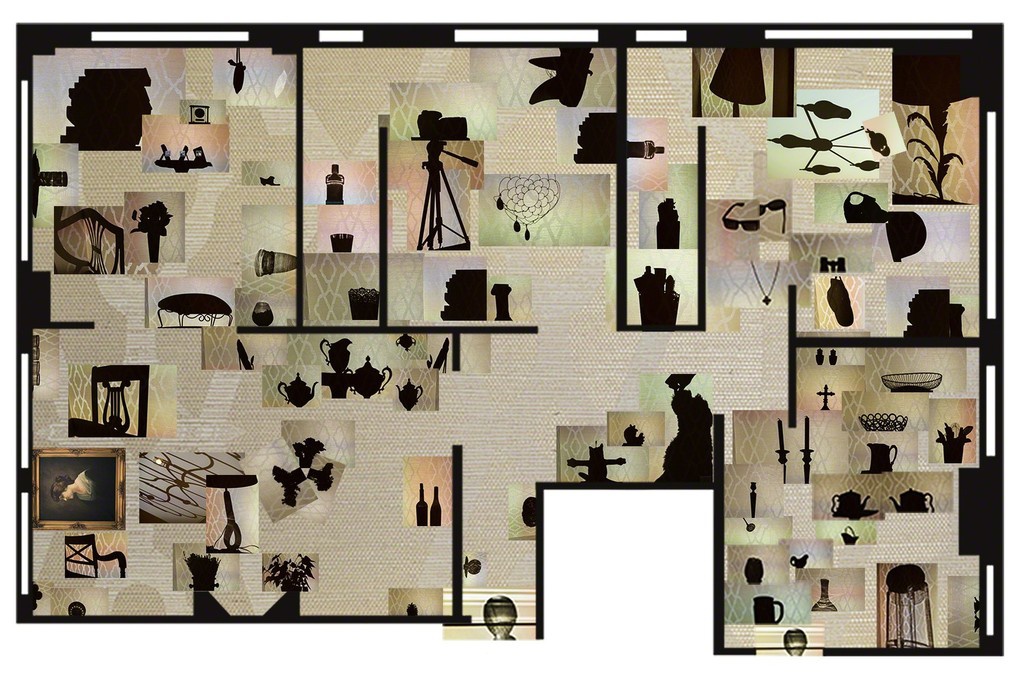
The shadow is an illusion of an accurate reality. In examining Cardozo's images, we begin to believe we can draw conclusions about the lives these people live. We begin to form judgements. But we are not fully informed. In "Blueprint 18- Angela and Bill", we do not know if these objects are inexpensive or collectible works. Were they inherited or purchased? Are they old from their far past or newly acquired and a more true indication of their interests today? Her art makes us open our eyes to know what we think we see, but it is not a complete picture, even though the image is accepted as a completed work.
Shadows have other meanings. Carl Jung expressed that our homes are a reflection of our psyche and that the darkness of shadows is the suppression of certain genetic characteristics. ""Everyone carries a shadow, and the less it is embodied in the individual's conscious life, the blacker and denser it is. At all counts, it forms an unconscious snag, thwarting our most well-meant intentions."

In "Blueprint 01-Self Portrait", we peek into Cardozo's own life. It was her first image. It is a new kind of portraiture. We can refer to these as "environmental self portraits". Dallas, Texas based photographer Susan Kae Grant also uses shadows in her work. In her description for "Night Journeys", she expressed: "Using the shadow as metaphor, I create images that explore notions associated with dreams and memory and provide pictorial access to the unconscious and unexplainable experiences." So shadows may be more than just the blockage of light by an object that is reflected on a wall in her images.
Cardozo is a city dweller used to living in a high density urban environment. Her images reflect that. She grew up in Sao Paulo, Brazil. Her recollections of growing up, ballet classes and summers spent in the countryside with her grandparents and cousins are expressed in photographs. Cardozo, when recalling the past, says: "It's interesting, photos come to mind …. I mean, I'm not remembering the facts per se but the images I have of those events." In "Blueprint #27-Dora", the image is not a person alive today, but was from her past, recalled and cherished. "Actually, it is based on my memories of a friend's apartment from my childhood, but she (Ms Dora) died many many years ago." Gaiety is evident in this image with silhouettes of elegant people dancing and a sense of a space where entertaining was welcome and frequent.
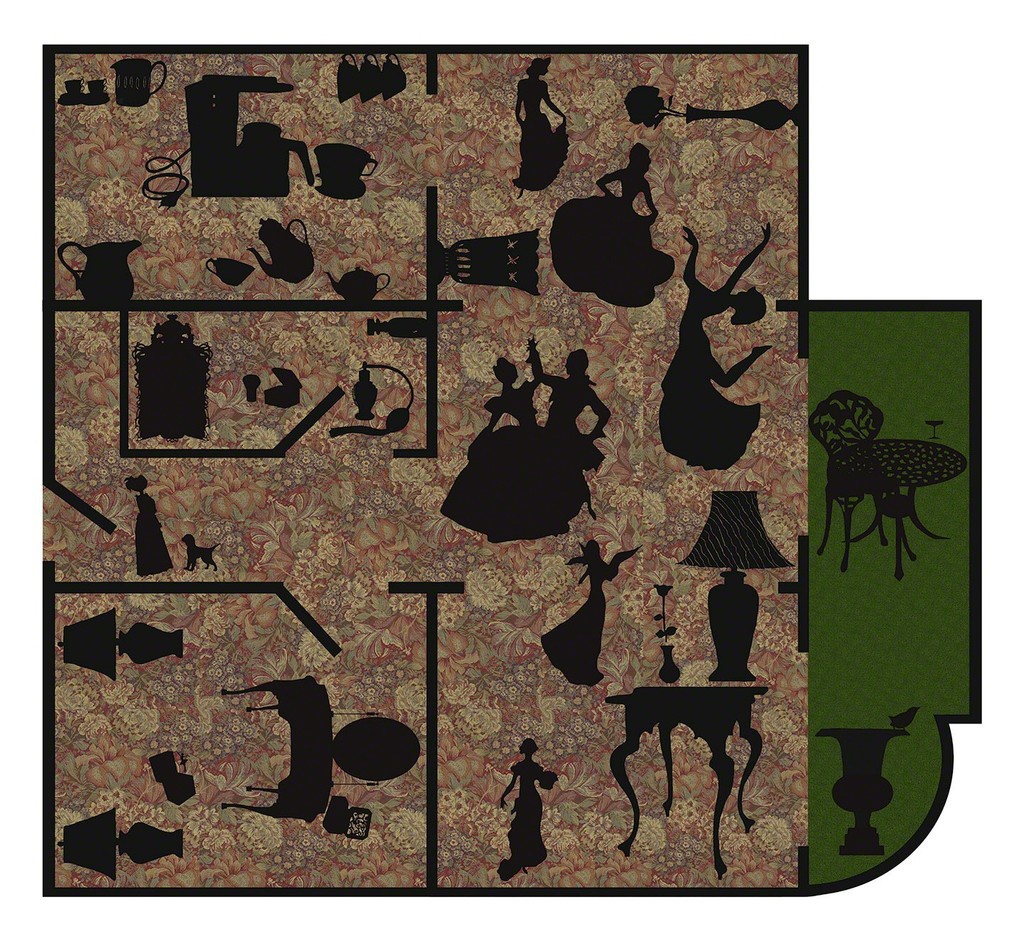 "Blueprint 27 - Dora" 2018. Image by Joana P. Cardozo ©
"Blueprint 27 - Dora" 2018. Image by Joana P. Cardozo ©
The work of Margeaux Walter similarly deals with spaces and our life patterns in her series "Sign Language". Both artists work with a defined space, but create their images very differently. Cardozo is creating portraits of others, while Walter's work is performance wherein she is the only actor. While Cardozo tackles an entire space, Walter focuses on a single place within a room. It may not even be the entire room, but only a portion. While Cardozo's works are ones of investigation and evidence through looking at what is in a place, Walter's work are performance with objects and actions of her choosing. Both Cardozo and Walter give us a view from above, looking down at and into a space. Walter is a prolific artist with many overlapping bodies of work, both still and video. Here, the fundamental question is what is meant by "sign language". What is hidden within each image within the visual presentation of each performance?
Walter is the only actor within each image. In "Borderline", she dresses as a stylish well-to-do woman who appears to be in a huge rush to do something. Her purse is flung open, her coffee is spilling, and she has lost a shoe off her foot. Walter's use of black and white seems to imply that this woman lives in two worlds. Both sides appear chaotic. One might suppose that the tension in one life carries over to create stress and imbalance in the other. To empathize with the woman, her instability, as she seems to be falling backwards, throws us, the viewer, off balance, too.
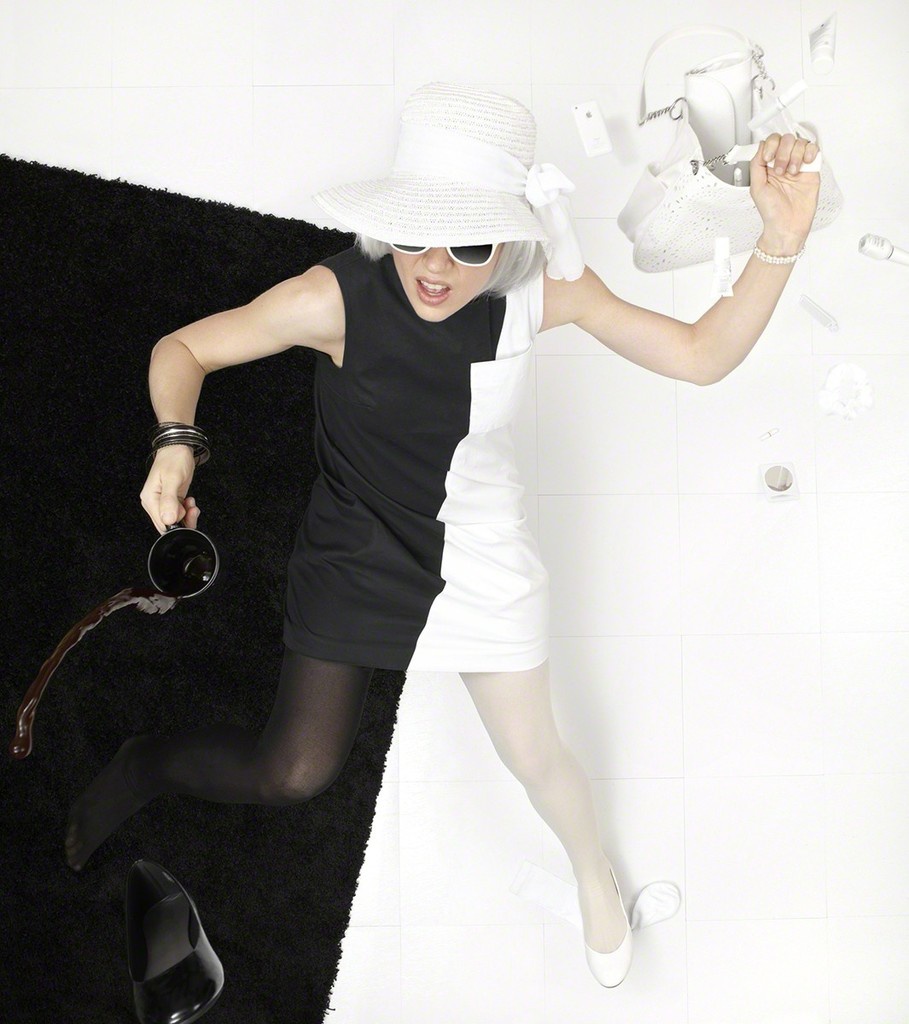
Photography became associated with performance art in the 1960's. How performers used photography developed from rejection to acceptance; from documentation to an integral and intentional part of conveyance of a message. In 2004, Karen Irvine, Associate Curator, Museum of Contemporary Photography (MoCP) at Columbia College, Chicago, wrote about the exhibition "Camera/Action: Performance and Photography": "Direct experience was what performance artists…valued most in their attempts to "re-site" art outside of standard art appreciation systems. They wanted to protest against the objectification and commercialization of the artwork, and as Dennis Oppenheim once said, "to stretch the limits of what can be done and to show others that art isn't just making objects to put into galleries. … Performance artists quickly realized that they relied on the documentation of their work to disseminate their ideas and actions to a larger audience." The artists created physically challenging endurance-based works, positioned the audience to interact with the works, or interpret expressions of identity through changing facial expressions and dress.
In 2011, MoMA exhibited "Staging Action: Performance in Photography since 1960" organized by Roxana Marcoci, Curator, and Eva Respini, Associate Curator, Department of Photography, The Museum of Modern Art. The exhibition focused on a number of performance artists wh are different than those highlighted in the earlier 2004 Museum of Contemporary Photography exhibition. The press release stated: "Though performances are often intended to be experienced live, in real time, with photography playing an ancillary function in recording them, these works function as independent, expressive pictures, often staged in the absence of a public audience. At the center of these pictures is a performer (often the artist), posing or enacting an action conceived for the photographic lens." These artists continued with endurance-based work, identity but more performance in dress and expression as well as a focus on political dissent and criticism of consumption.
Walter incorporates herself into the performance with multiple staged images. This is not unlike the German born photographer Barbara Probst who takes simultaneous images from different angles of herself and others in a variety of situations. With Walters, the images are captured from a variety of angles, albeit in a technique that is non-simultaneous, in contrast to Probst. Walter commented on the effort in creating each of her images: "[M]y process of creating the works … is a long process of trial and error to align perfectly within the set and image. With my camera on a timer I go back and forth until I get it perfectly aligned." Walter splits time into spatial rather than linear motion. She creates a space using changing costumes, frozen segments of movement and color, to frame a message and focus our attention.
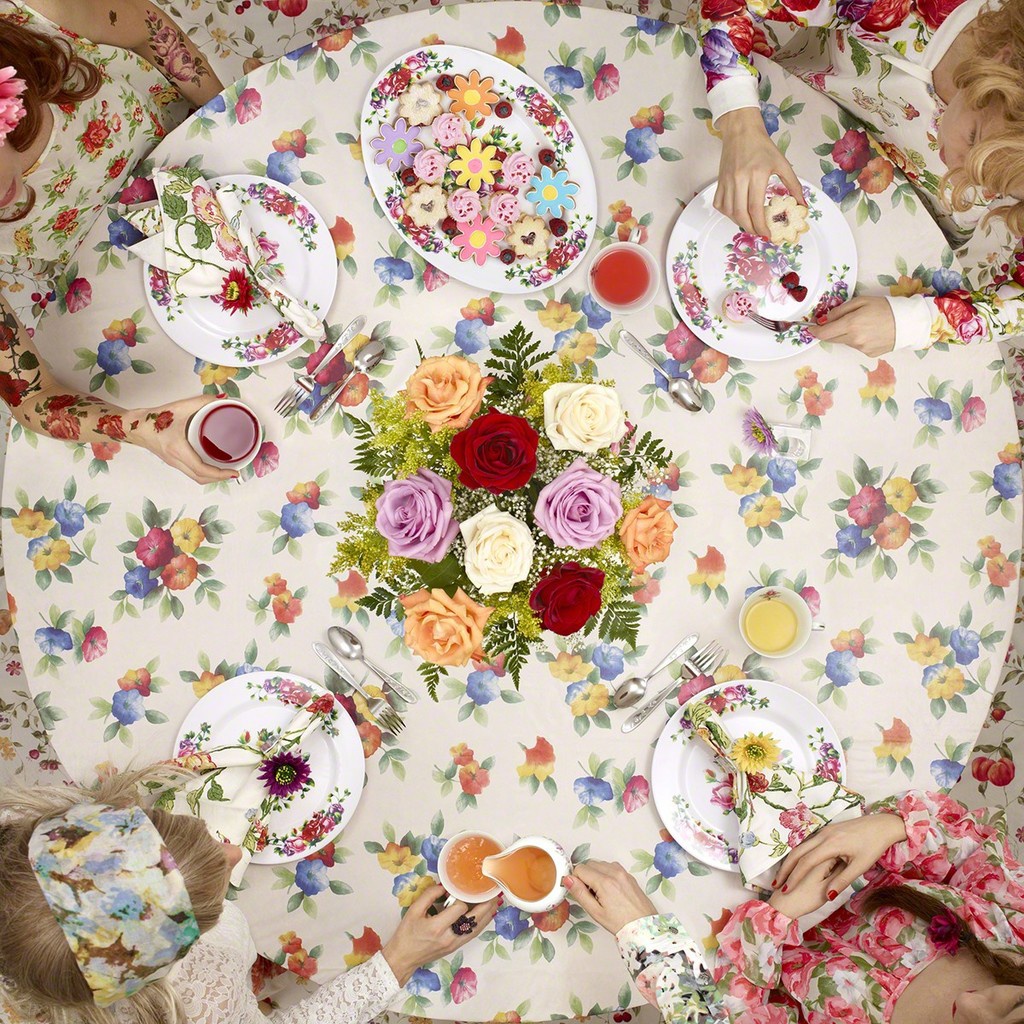 "In Bloom" from the series "Sign Language" 2015 by Margeaux Walter ©
"In Bloom" from the series "Sign Language" 2015 by Margeaux Walter ©
Walter's "In Bloom" is a playful entrance into a world of comfort, refined society and pleasures few can enjoy. It seems to be a lovely tea party. Everyone is elegantly dressed and looks healthy and fit. Beautiful flowers are everywhere; on the table, printed on the napkins and tablecloth, woven into the dresses of the four costumes Walters wears in this performance piece. One participant even has flowers tattooed onto her arm. All of the plates and cookies are designed like flowers. It is an image of gaiety. It is an oasis in a world that is not at all elegant and pleasing. With the image, Walter shows how we can build invisible barriers, isolate and insulate ourselves. In our consumer culture, we surround ourselves with a special setting and hold the outside world's uncomfortable conditions at bay.
Walter's work is also a comment on identity. What is identity? Her concern is with the onslaught of consumer culture which bombards us constantly, soaking away our individuality. It encourages us to want to own the same things. To wear the same things, to fit in and be, in some unsettlingly way, on common ground with others. A recurring theme is also the influence of technology on us individually and how it isolates us from others and our own selves. The concerns over technology are wonderfully expressed by Walter in an earlier 2012 series, "TMI" ("Too Much Information"), and continues as theme through-out her work, including "Sign Language".
In her images, Walter switches roles between male and female. The use of color lessens our focus on the gender identity. Even though we know it is always Walter in the images, her characters represent different stereotypes of gender, age and perceived demographics. She comments that she is concerned with privilege and our consumer culture.
Political expression is part of the performance genre that originated in the 1960s and 1970s and continues today with artist such as Ai Weiwei and Robin Rhode. In the MoMA news release for their 2011 exhibition, they commented "Ai Weiwei's photographic series Study of Perspective (1995-2003) reveals a spirited irreverence toward national monuments. Traveling to various landmarks-from the Eiffel Tower to Tiananmen Square to the White House-the artist photographed his own arm extended in front of the camera's lens as he gave each marker the middle finger." Walter is not irreverent politically in her images, but commenting on how we are enveloped and disappear into our surroundings. Her videos "Eddy's Place" (2016) , "Act of God" (2014) and "Where Everyday Begins" (2014) are examples of her reaction to the places we live. South African multimedia artist Robin Rhode creates work where he interacts with drawings on walls or the ground in multiple panels of sequenced action. He comments on the lives we lead. His work differs from Walter in her single frame presentation of multiple actions, but is similar in spirit to her video performances.
Another technique Walter uses are "lenticular" images. Lenticular works contain some combination of images that alter in appearance as the viewer walks past the art looking at the image from different angles. The change of one image to another gives the viewer a changing scene, a new view and message, depth, and place. It is another way Walter performs for us in her work.
A work like "Sunday Best" in her series "Becoming" illustrates her concern with outward appearance. Here is a woman (again played by Walter) who can not make up her mind as to what to wear. On one image, she stands before a full closet of dresses, shoes and scarves. In the next image, as we move past the lenticular print, her frustration is evident as the clothes fly around the room and she collapses yet undressed to the floor in apparent frustration about the choice to be made. That full closet is less prop than a truly overflowing closet. Walter does in fact have a large collection of wigs and clothing that she uses in her performance images.
Walter also uses color to punctuate her images. Is color an expression of temperament? Color can dominate and evolve a space. In an interview in Fraction Magazine (Issue 107), Walter commented on the use of color: "Each image is a physical scene that is then deconstructed through color and pattern into varying levels of chaos and order, obscuring the identities of the figures within them." Alternatively, a space may be any number of colors that remake or redefine ourselves as we pass from one area to the next. Her inspiration for color may come from a painting of an artist she loves, or literally a mass-produced carpet whose colors fit her idea for an image.
 "Cocoon" from the series "Sign Language" 2014 by Margeaux Walter ©
"Cocoon" from the series "Sign Language" 2014 by Margeaux Walter ©
In "Cocoon", Walter creates an existence defined by shades of neutral grays and browns. In this scene technology sterilizes human interaction. Two people are seated in a room facing each other. There appears to be no conversation as the person in gray on the couch is working on a computer, as many of us do. The space appears sterile, silent, formal and rigid despite a room that suggests being in the comfort of one's home. Walter reminds us that while being connected is now part of our lives, there is a price and a consequence.
With the examination of the work of Margeaux Walter and Joana P. Cardozo, we examine ourselves. Whether we like it or not, when we look at others, we think of ourselves in comparison, often unconsciously. Both artists move us to think about why we live the way we do. As we visit the spaces created for us in these images, we think of what we ourselves own and have, or do not have. The artists remind us, with use of color, that our world is not necessarily black or white. Whether evidence and knowledge of what we see is hidden in Plato-like shadows, or rained upon us through mass and social media, both artists shed light on a subject, create dialogue and trigger conversation. The compositions of Joana P. Cardozo and Margeaux Walter give us reasons to think about how what we have reflects ourselves to others. In each of their images, the artists leave cues and messages. What messages do we send, and is that how we wish to be understood?

